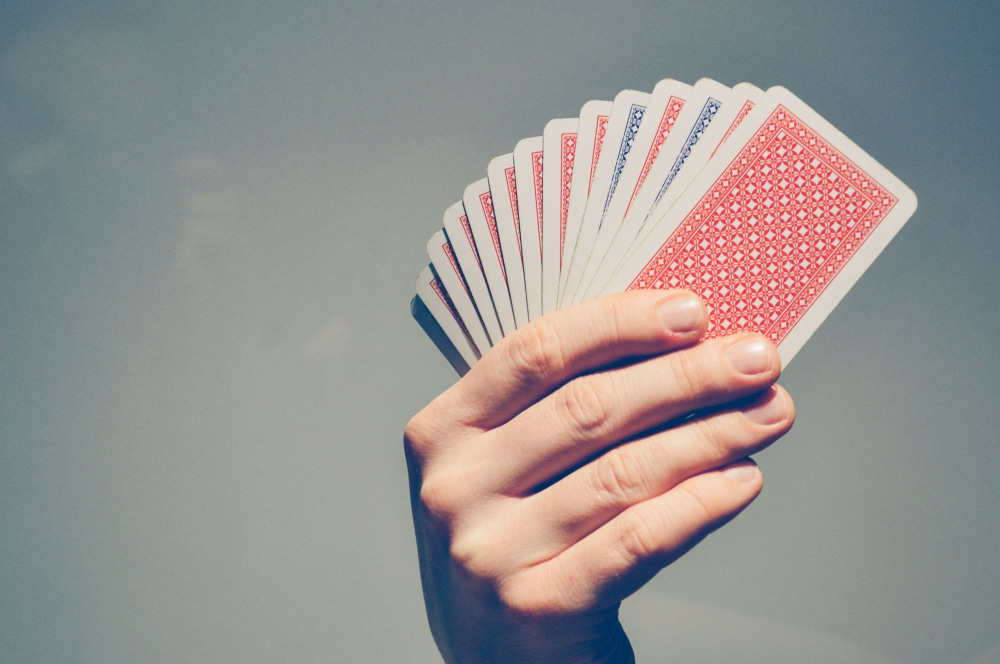The Go Fish card game is a pleasant and slow-paced card game that’s famously played between children and their parents or caretakers. As a social and learning experience, Go Fish is gently competitive but ends up feeling collaborative, which is a great way to ease children into the spirit of more competitive and more complex card games later on.
In this article, you’ll learn everything there is to know about how to play the Go Fish card game, who should play it, and what kind of skills that the players will pick up as a result of playing.
Who Is Go Fish Intended For?
The Go Fish card game is for children of ages 4 and up.
This means that if you’re an adult playing Go Fish, your primary job is to make sure that the child or children playing with you are following the rules and getting the optimal educational experience from the game.
The Fish card game can teach skills like:
- How to organize cards
- How to physically manipulate a hand of cards
- How to be a good sport
- How to follow basic rules
- How to wait for your turn
- How to shuffle cards
- How to identify which cards are valuable to other players
The Go Fish card game will be a bore for adults, who will find its rules too simple and its deterministic outcome too random to be entertaining. For children under age 10, Go Fish can be a bundle of fun.
Before the start of the game, it can help to coach players with basic techniques like how to hold their cards properly and how to shuffle properly, as these may be skills that their dexterity is still struggling to match their mental understanding of what they should be doing.
What Do I Need To Play Go Fish?
To play the card game Go Fish, you’ll need:
- A single deck of normal playing cards
- At least one other player, but fewer than five other players
- A flat surface that all players can reach
- Patience and a good attitude
It helps if the players have basic competence in understanding numbers, but the Go Fish card game can work on these skills, too.
What Are The Rules Of Go Fish?
The rules for the Go Fish card game are straightforward by design. First, remove the jokers from your deck of playing cards, and get the players seated around a table.
The dealer should be the adult or the most experienced player. Shuffle the cards, then deal seven cards to each player and leave the remaining cards in a stack. If you are only playing Go Fish with two players, then you should deal each player ten cards. If you’re playing with five players, deal each player only five cards.
You shouldn’t need to introduce any additional decks of cards to play a Go Fish Game; if there are more than five players, break up into two groups.
Players pick up their cards and can look at them. There’s no rule against showing cards to other players, but most games of Go Fish are played with a closed hand, so players should be encouraged to hide their hands from each other.
Starting A Game Of Go Fish
The objective of Go Fish is to make sets of four of a kind. Once these sets are completed in the player’s hand, they play on the table face up, but this action can only occur during a player’s turn.
The player who sits to the left of the dealer plays first and can take several actions.
The most common action that a player performs is inquiring whether another player has a certain type of card. To do this, the player picks one other player if they have any of the kind of card that they are trying to find to make a four-of-a-kind set.
For example, if Simon has three twos and is trying to see if Jenelle has the fourth two so that he can play the complete set, during Simon’s turn he can ask, “Jenelle, do you have any twos?”
If Jenelle does, in fact, have a two, she must turn it over to Simon, who can then pose another question to Jenelle or any other player. Simon continues to go fishing until nobody has the kind of card that he wants.
Once this happens, Simon’s turn is over, but Simon can then “Go Fish,” after which Simon draws a card from the top of the pile. Play continues with the next person to the left.
If the player draws a card that is the card they were looking for, they must reveal that card to all other players, and they are allowed to take another turn.
The game ends when all of the sets of four are in play on the table. The player’s objective is to make the most sets of four. The winner is the player that has made the most sets of four, so each set should stay close to each player if you aren’t using an alternative accounting system for scoring.
Caveats
There are a few additional rules to keep track of that are rarely needed.
Players can only request cards from other players if they have one of the cards in that set in their hand. This means that players can’t arbitrarily fish for nearly completed sets that another player has spent their time forming.
Additionally, if a player runs out of cards by making all of the cards in their hand into sets, the player who ran out of cards simply draws an additional card and can then begin asking for cards in that set.
Educational Go Fish
When you’re playing Go Fish with elementary school-aged children, there are some objectives and focus areas that you as the adult need to watch. First, make sure that all players are clear on the rule that they need one card of the kind that they are fishing for in their hand before they are allowed to fish for it.
Second, make sure that players treat each other with dignity and respect while requesting cards and also while handing their cards over. Losing a nearly complete set can be frustrating for young children.
Third, given the importance of figuring out what is in each player’s hand, it may be useful for you to employ some physical blocking devices to prevent the unintentional showing of hands. Young children are typically very careless when it comes to keeping their cards close to the chest.
You should also make sure that players get the idea that organizing their card based on how many of a card they have is a good strategy because it helps them stay organized and understand what their next inquiry should be.
Try to prod players to wait for their turn, ensure that they’re playing fairly, and maintain good concealment of their cards so that other players can’t see what’s in their hand. For more advanced Go Fish players, you may want to encourage them to think about what might be in the other players’ hands and what cards might still be in the stack.
Finally, it always helps to prod the players along with the things they should do if it isn’t clear to them. While the game’s rules are relatively simple, the most obvious moves can sometimes confound young children who are still trying to wrap their head around basic concepts like making sets while also dealing with difficulty in physically manipulating a hand of cards.
Spending An Afternoon Going Fishing
Playing Go Fish is a relaxing way to spend social and educational time with children, and most games won’t go any longer than 45 minutes. Most of the time in Go Fish games is spent on players contemplating their moves, so don’t be afraid to intervene and make a suggestion if it seems that one of your players is bamboozled by their abundant number of choices.
The ideal size for a Go Fish game is probably one adult and three or four children. Make sure that everyone is asking for the other players’ cards by name to build good social habits, and make sure that at the end people are congratulatory to the winner rather than bummed out because they have lost.
If you want a little bit of extra fun, you can keep score of how many sets each player has made on a separate notepad, and mix the completed sets around in the middle of the table to look like a fish pond—it seems silly because it is silly, but little children often find it to be a hugely entertaining improvement to the state of play.

